All Paper Economy
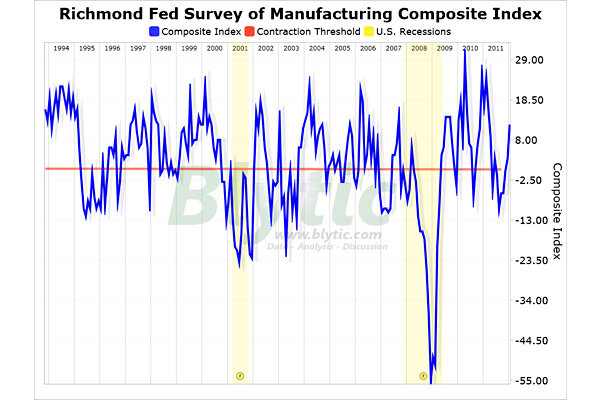 Manufacturing improvesThe Federal Reserve Bank of Richmond's Survey of Manufacturing Activity for January showed that the composite index, the broadest measure of manufacturing activity, improved 9 points to a level of 12.
Manufacturing improvesThe Federal Reserve Bank of Richmond's Survey of Manufacturing Activity for January showed that the composite index, the broadest measure of manufacturing activity, improved 9 points to a level of 12. Single family home sales are upSingle family home sales increased 4.6 percent from November and rose 4.3 percent above the level seen in December 2010
Single family home sales are upSingle family home sales increased 4.6 percent from November and rose 4.3 percent above the level seen in December 2010 Residential construction improves, but the market is fragileSingle family housing permits, the most leading of indicators, increased 1.8% from last month, but the environment for new home sales remains weak
Residential construction improves, but the market is fragileSingle family housing permits, the most leading of indicators, increased 1.8% from last month, but the environment for new home sales remains weak Jobless claims lowest in three years“Initial” unemployment dropped 50,000 to 352,000 claims, while seasonally adjusted “continued” claims declined by 215,000
Jobless claims lowest in three years“Initial” unemployment dropped 50,000 to 352,000 claims, while seasonally adjusted “continued” claims declined by 215,000 Finally, some good news for the housing marketThe latest housing market index shows that all measures increased in January, propelling the composite HMI index to its highest level since 2007
Finally, some good news for the housing marketThe latest housing market index shows that all measures increased in January, propelling the composite HMI index to its highest level since 2007 Mortgage rates continue fallingThe average rate for a 30-year fixed rate mortgage dropped to 3.98% since last week.
Mortgage rates continue fallingThe average rate for a 30-year fixed rate mortgage dropped to 3.98% since last week. Manufacturing perks upThe Empire State Manufacturing Survey shows a notable improvement in manufacturing activity
Manufacturing perks upThe Empire State Manufacturing Survey shows a notable improvement in manufacturing activity Consumer confidence improvesThe University of Michigan's Index of Consumer Expectations rose to 68.4, and the Current Economic Conditions Index climbed to 82.6.
Consumer confidence improvesThe University of Michigan's Index of Consumer Expectations rose to 68.4, and the Current Economic Conditions Index climbed to 82.6. Retail sales show weak increaseIn December, retail sales increased 0.1 percent from November and 6.5 percent on a year over year basis
Retail sales show weak increaseIn December, retail sales increased 0.1 percent from November and 6.5 percent on a year over year basis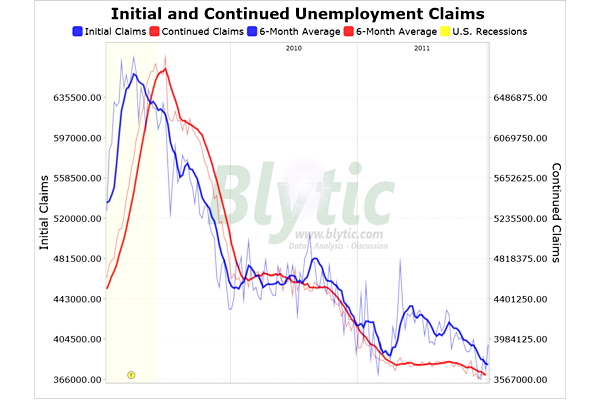 Jobless claims have gone upDespite last week's good job market news, new unemployment claims increased by 24000
Jobless claims have gone upDespite last week's good job market news, new unemployment claims increased by 24000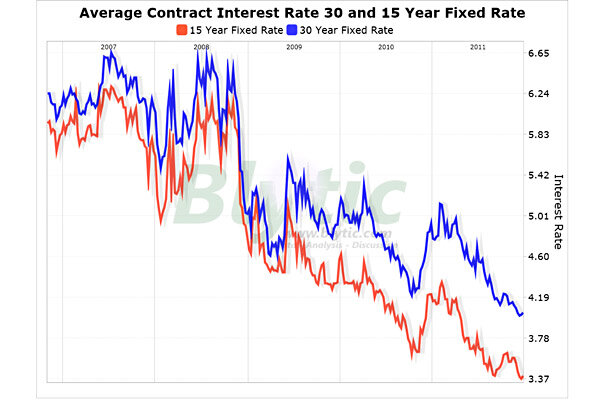 Mortgage rates trend lower and lowerThe average rate for a 30 year fixed rate mortgage (from FHA and conforming GSE data) increased 2 basis points to 4.03% since last week, but the overall trend continues to slide
Mortgage rates trend lower and lowerThe average rate for a 30 year fixed rate mortgage (from FHA and conforming GSE data) increased 2 basis points to 4.03% since last week, but the overall trend continues to slide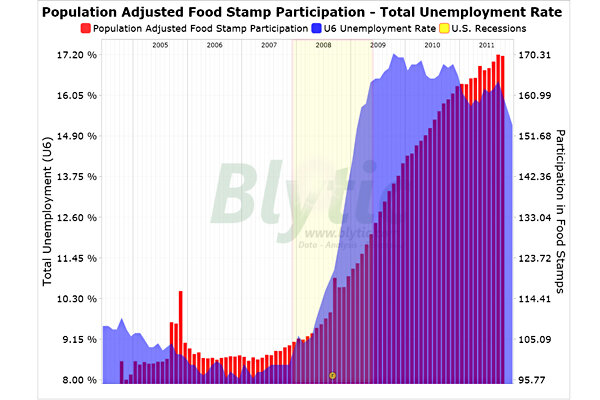 Food stamp use still rising despite good jobs newsHousehold food stamp participation has been climbing so steadily that it has far surpassed the last peak, set as a result of Hurricane Katrina
Food stamp use still rising despite good jobs newsHousehold food stamp participation has been climbing so steadily that it has far surpassed the last peak, set as a result of Hurricane Katrina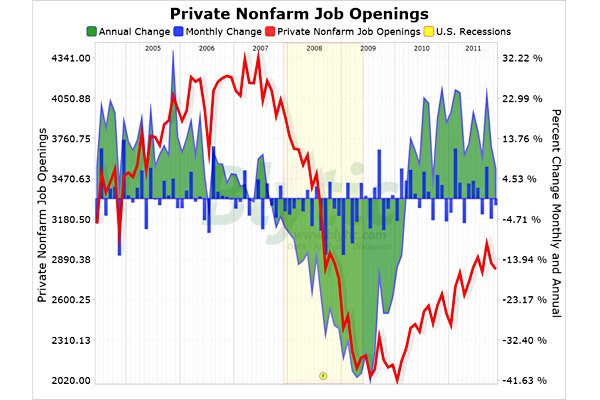 New job openings decreasePrivate job openings declined 1.57 percent since October, and layoffs increased 5.68 percent
New job openings decreasePrivate job openings declined 1.57 percent since October, and layoffs increased 5.68 percent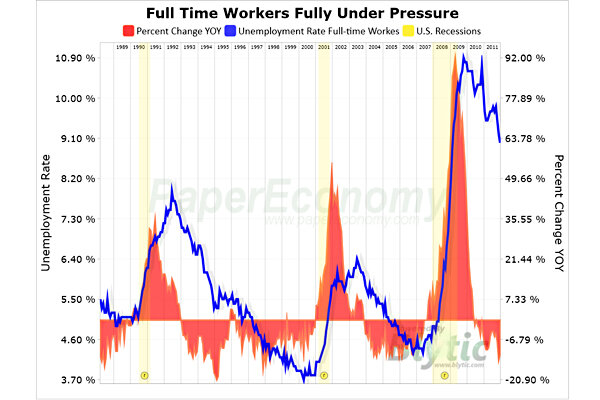 Full time unemployment dropsThe full time unemployment rate declined to 9.0 percent of the civilian workforce but remains near the highest rate seen in 41 years.
Full time unemployment dropsThe full time unemployment rate declined to 9.0 percent of the civilian workforce but remains near the highest rate seen in 41 years.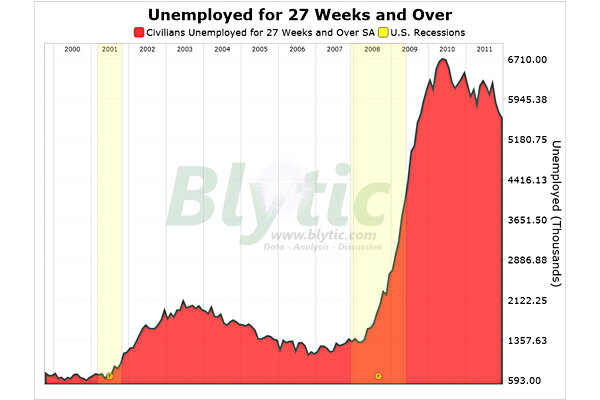 Long term unemployment drops; still highWorkers unemployed 27 weeks or more declined to 5.588 million, and the average stay on unemployment declined to 40.8 weeks.
Long term unemployment drops; still highWorkers unemployed 27 weeks or more declined to 5.588 million, and the average stay on unemployment declined to 40.8 weeks. Private employment up in DecemberPrivate employers added 325,000 jobs in December, bringing the total employment level 1.81 percent above the level seen in December 2010
Private employment up in DecemberPrivate employers added 325,000 jobs in December, bringing the total employment level 1.81 percent above the level seen in December 2010 Unemployment rate drops to 8.5 percentThe 'total unemployment' rate fell to 15.2 percent in December, while the traditionally reported unemployment rate dropped to 8.5 percent
Unemployment rate drops to 8.5 percentThe 'total unemployment' rate fell to 15.2 percent in December, while the traditionally reported unemployment rate dropped to 8.5 percent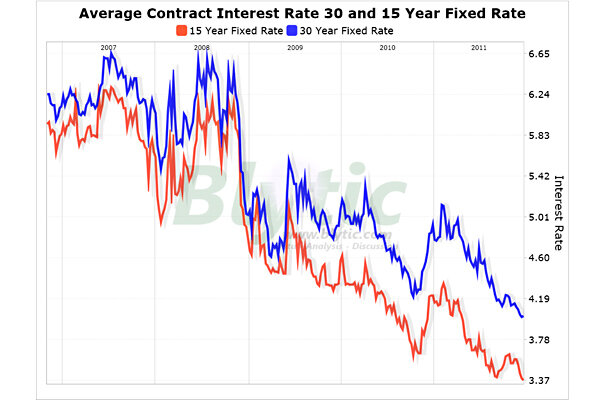 Mortgage rates increase slightlyThe average rate for a 30-year fixed rate mortgage increased to 4.01 percent, an increase of one basis point from last week.
Mortgage rates increase slightlyThe average rate for a 30-year fixed rate mortgage increased to 4.01 percent, an increase of one basis point from last week.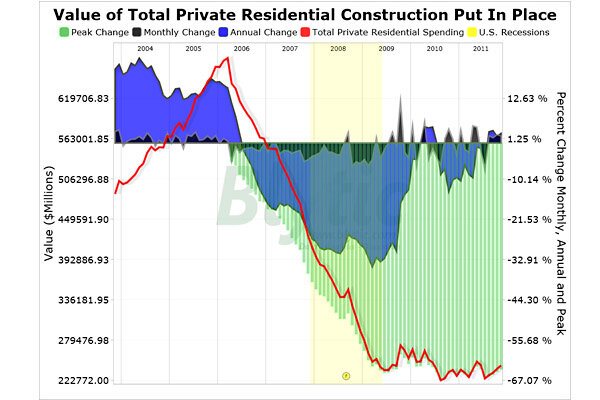 November construction spending shows weak expansionResidential spending increased 2.01 percent from October but remained 63.97 percent below the peak level seen in 2006
November construction spending shows weak expansionResidential spending increased 2.01 percent from October but remained 63.97 percent below the peak level seen in 2006



